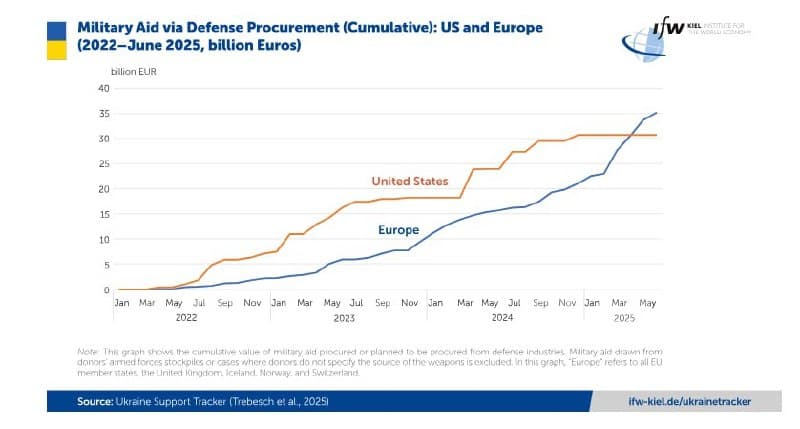Europe Outpaces U.S. in Military Aid to Ukraine, Allocating €35.1B Amidst Crisis
In a significant shift in the dynamics of military support for Ukraine, European nations have surpassed the United States in military-industrial output, with a reported allocation of €35.1 billion compared to the U.S."s €30.7 billion. This marks a pivotal moment since Russia"s invasion of Ukraine in 2022, highlighting Europe"s increasing commitment to bolstering Ukraine"s defense capabilities in the ongoing conflict.
Background & Context
The conflict in Ukraine, which began with Russia"s aggressive military actions in February 2022, has prompted a global response characterized by unprecedented levels of military and humanitarian aid. Initially, the U.S. was the dominant force in providing assistance, but recent reports indicate a shift as European nations rally to support Ukraine more robustly. The European Union (EU), alongside other European states, has not only increased its financial contributions but has also surpassed the U.S. in terms of total military aid, tanks, and critical weaponry.
This change reflects a strategic reassessment among European countries, many of which share borders with Russia and are acutely aware of the potential threats to their own security. Germany has emerged as the leading donor by value in this effort, signaling a renewed commitment to European defense and solidarity with Ukraine.
Key Developments
According to a recent report by Defense News, the military aid allocated by European nations includes not only financial support but also tangible military assets that are crucial for Ukraine"s defense. This includes tanks, artillery, and advanced weapon systems, which are essential for combating the ongoing Russian offensive. Germany"s leadership in this initiative underscores a significant policy shift, as the country previously maintained a more cautious approach to military aid due to its historical context.
The numbers indicate a robust collective effort, with various EU member states contributing to the overall military aid package. This includes countries like France, Poland, and the Baltic states, each playing a vital role in ensuring that Ukraine has the necessary resources to defend itself against Russian aggression. This collaboration among European nations signals a united front and a commitment to enhancing regional security.
Broader Impact
The implications of Europe surpassing the U.S. in military aid to Ukraine extend beyond immediate military support. Analysts suggest that this shift could redefine transatlantic relations, potentially leading to a more balanced partnership between the U.S. and Europe in matters of defense and security. Some experts argue that a more autonomous European defense posture could lead to a new strategic landscape, where European nations play a more prominent role in their own security affairs.
This increased military spending and support for Ukraine may also influence NATO"s future strategies and deployments. As European nations take on more responsibility, the alliance may see a shift in its operational focus, prioritizing collective defense initiatives that resonate with the current geopolitical climate. The long-term effects of this transformation could reshape the security architecture of Europe for years to come.
What"s Next
As the situation in Ukraine continues to evolve, the focus now shifts to how European nations will manage and sustain their military support. Upcoming discussions within NATO and the EU will likely address long-term strategies for providing ongoing assistance to Ukraine, including how to replenish stockpiles and ensure that aid remains consistent and effective.
Moreover, the international community will be watching closely for any indications of further escalations in the conflict, which could necessitate even greater levels of support. As previously reported, recent developments such as urgent prisoner exchanges and military engagements near key battlegrounds like Pokrovsk will influence both public sentiment and policy decisions regarding military aid.
In the coming weeks, leaders from various European nations are expected to convene to discuss the future of their military commitments, ensuring that Ukraine remains a priority in the face of ongoing challenges. This pivotal moment in military aid not only reflects a response to immediate threats but also sets the stage for a transformed European security landscape.







